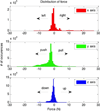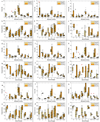Characterization of force and torque interactions during a simulated transgastric appendectomy procedure
- PMID: 25398173
- PMCID: PMC4344408
- DOI: 10.1109/TBME.2014.2369956
Characterization of force and torque interactions during a simulated transgastric appendectomy procedure
Abstract
We have developed an instrumented endoscope grip handle equipped with a six-axis load cell and measured forces and torques during a simulated transgastric natural orifice translumenal endoscopic surgery appendectomy procedure performed in an EASIE-R ex vivo simulator. The data were collected from ten participating surgeons of varying degrees of expertise which was analyzed to compute a set of six force and torque parameters for each coordinate axis for each of the nine tasks of the appendectomy procedure. The mean push/pull force was found to be 3.64 N (σ = 3.54 N) in the push direction and the mean torque was 3.3 N · mm (σ = 38.6 N · mm) in the counterclockwise direction about the push/pull axis. Most interestingly, the force and torque data about the nondominant x and z axes showed a statistically significant difference (p < 0.05) between the expert and novice groups for five of the nine tasks. These data may be useful in developing surgical platforms especially new haptic devices and simulation systems for emerging natural orifice procedures.
Figures











References
-
- Rattner D, Kalloo A. ASGE/SAGES Working Group on Natural Orifice Translumenal Endoscopic Surgery: October 2005. Surg. Endosc. 2006 Jan;20(2):329–333. - PubMed
-
- Pai RD, Fong DG, Bundga ME, Odze RD, Rattner DW, Thompson CC. Transcolonic endoscopic cholecystectomy: a NOTES survival study in a porcine model (with video) Gastrointest. Endosc. 2006 Sep;64(3):428–434. - PubMed
-
- Rolanda C, Lima E, Pêgo JM, Henriques-Coelho T, Silva D, Moreira I, Macedo G, Carvalho JL, Correia-Pinto J. Third-generation cholecystectomy by natural orifices: transgastric and transvesical combined approach (with video) Gastrointest. Endosc. 2007 Jan;65(1):111–117. - PubMed
-
- Wagh MS, Thompson CC. Surgery Insight: natural orifice transluminal endoscopic surgery[mdash]an analysis of work to date. Nat Clin Pr. Gastroenterol Hepatol. 2007 Jul;4(7):386–392. - PubMed
-
- Zorron R, Palanivelu C, Galvão Neto MP, Ramos A, Salinas G, Burghardt J, DeCarli L, Henrique Sousa L, Forgione A, Pugliese R, Branco AJ, Balashanmugan TS, Boza C, Corcione F, D’Ávila Avila F, Arturo Gómez N, Galvão Ribeiro PA, Martins S, Filgueiras M, Gellert K, Wood Branco A, Kondo W, Inacio Sanseverino J, de Sousa JAG, Saavedra L, Ramírez E, Campos J, Sivakumar K, Rajan Pidigu Seshiyer, Jategaonkar Priyadarshan Anand, Ranagrajan M, Parthasarathi R, Senthilnathan P, Prasad M, Cuccurullo D, Müller V. International Multicenter Trial on Clinical Natural Orifice Surgery—NOTES IMTN Study: Preliminary Results of 362 Patients. Surg. Innov. 2010 Jun;17(2):142–158. - PubMed

